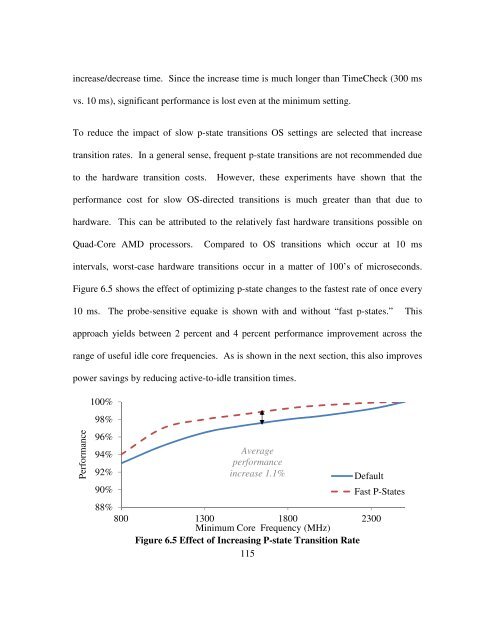Copyright by William Lloyd Bircher 2010 - The Laboratory for ...
Copyright by William Lloyd Bircher 2010 - The Laboratory for ...
Copyright by William Lloyd Bircher 2010 - The Laboratory for ...
Create successful ePaper yourself
Turn your PDF publications into a flip-book with our unique Google optimized e-Paper software.
increase/decrease time. Since the increase time is much longer than TimeCheck (300 ms<br />
vs. 10 ms), significant per<strong>for</strong>mance is lost even at the minimum setting.<br />
To reduce the impact of slow p-state transitions OS settings are selected that increase<br />
transition rates. In a general sense, frequent p-state transitions are not recommended due<br />
to the hardware transition costs. However, these experiments have shown that the<br />
per<strong>for</strong>mance cost <strong>for</strong> slow OS-directed transitions is much greater than that due to<br />
hardware. This can be attributed to the relatively fast hardware transitions possible on<br />
Quad-Core AMD processors. Compared to OS transitions which occur at 10 ms<br />
intervals, worst-case hardware transitions occur in a matter of 100’s of microseconds.<br />
Figure 6.5 shows the effect of optimizing p-state changes to the fastest rate of once every<br />
10 ms. <strong>The</strong> probe-sensitive equake is shown with and without “fast p-states.” This<br />
approach yields between 2 percent and 4 percent per<strong>for</strong>mance improvement across the<br />
range of useful idle core frequencies. As is shown in the next section, this also improves<br />
power savings <strong>by</strong> reducing active-to-idle transition times.<br />
Per<strong>for</strong>mance<br />
100%<br />
98%<br />
96%<br />
94%<br />
92%<br />
90%<br />
Average<br />
per<strong>for</strong>mance<br />
increase 1.1%<br />
Default<br />
Fast P-States<br />
88%<br />
800 1300 1800 2300<br />
Minimum Core Frequency (MHz)<br />
Figure 6.5 Effect of Increasing P-state Transition Rate<br />
115




